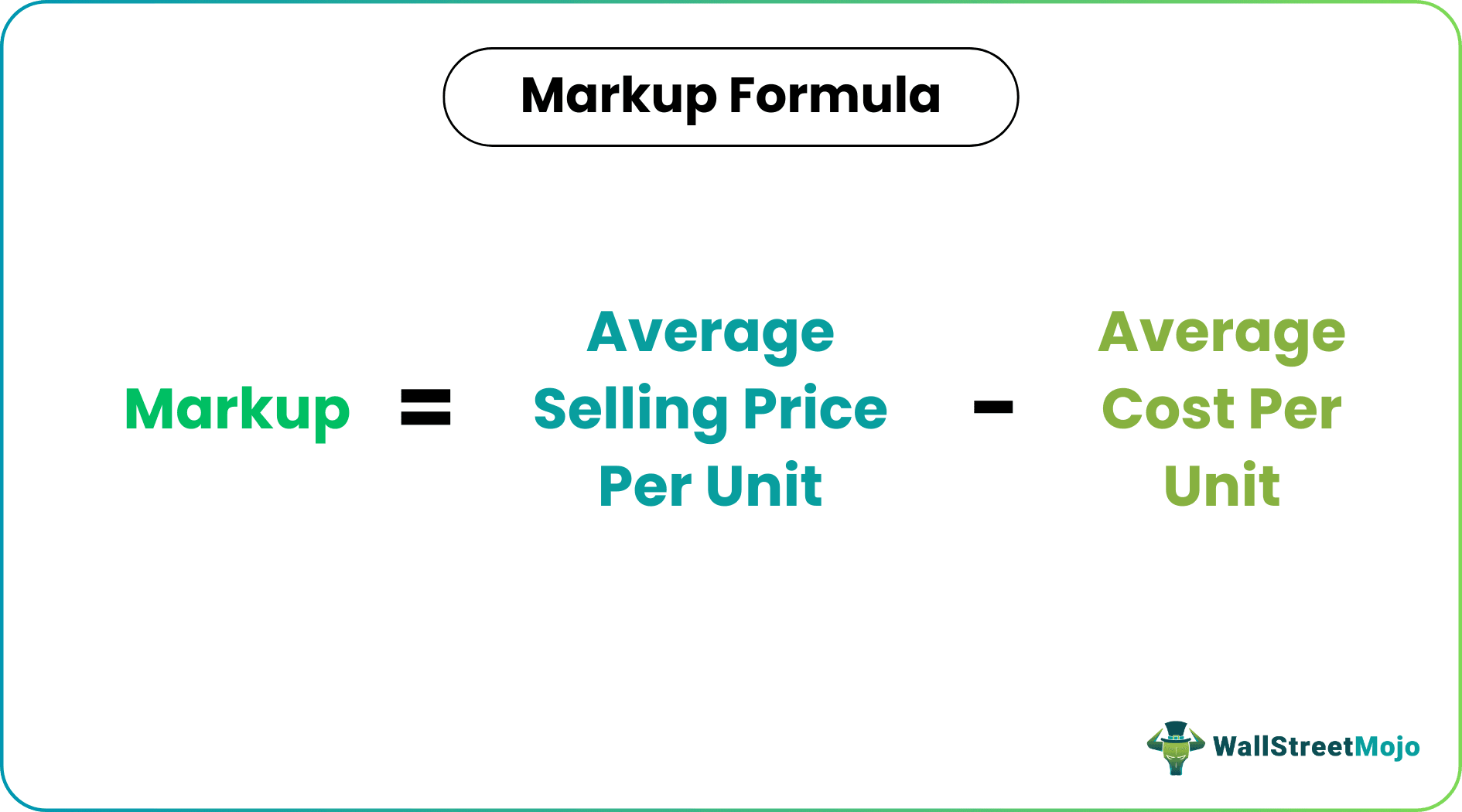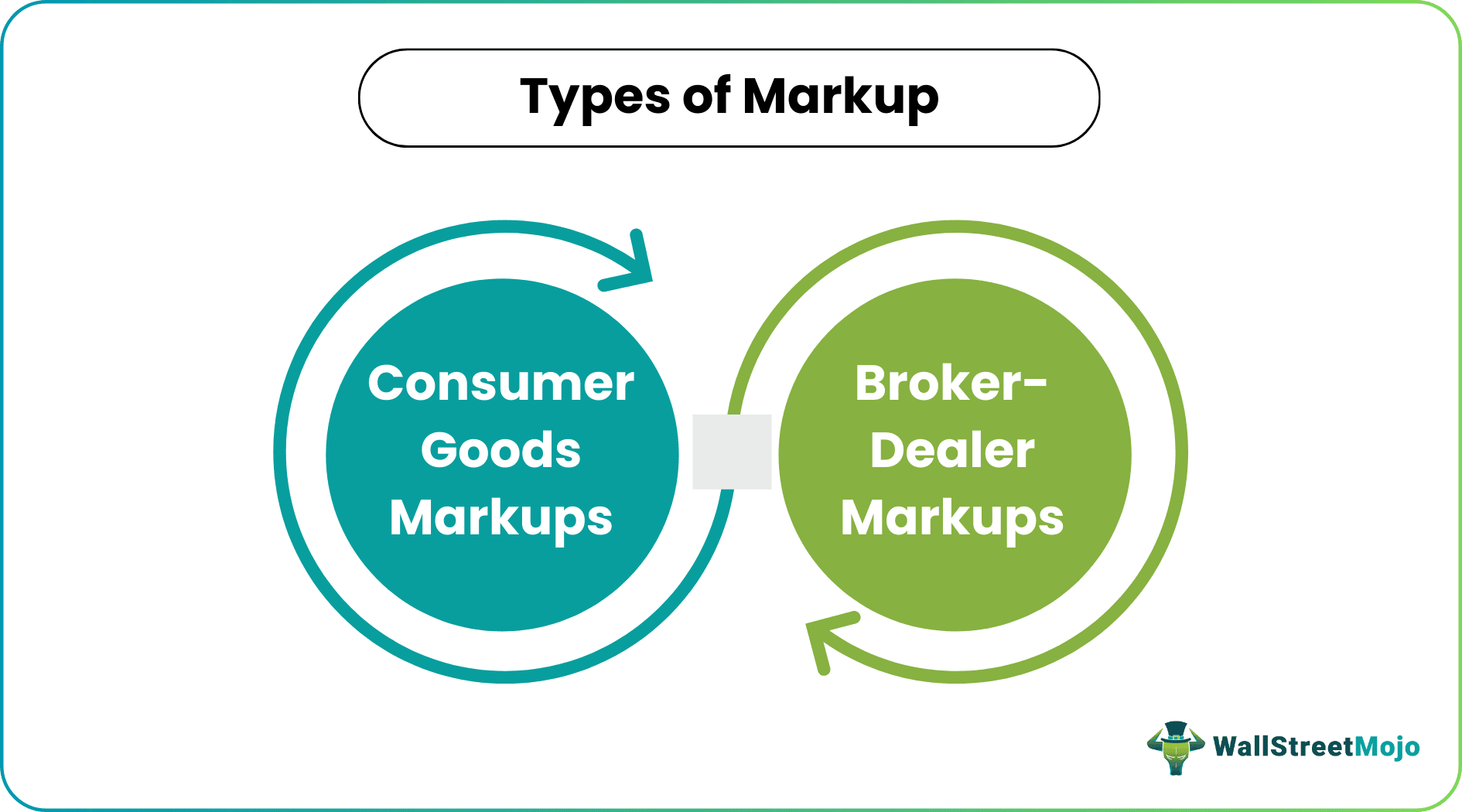Table Of Contents
Markup Meaning
Markup refers to the percentage of profits which the company derives during the period over cost price of the product sold by it, and the same is calculated by dividing total profits of the company of the period by the cost price of the product and then multiplying the resultant with 100 to derive the markup percentage.

It may also be the difference between an investment or security’s lowest current offering price in contrast to the price charged to the customers, which is usually common among broker-dealers.
Key Takeaways
- Markup refers to the percentage of profit a company earns on a product's sale over its cost price during a specific period.
- The markup percentage can be calculated by dividing the company's total profits during the period by the product's cost price and multiplying the result by 100.
- Different types of markups exist, including consumer goods markups and broker-dealer markups.
- These markups help estimate insurance companies' probability and play a crucial role in determining future policy premiums as companies adjust pricing to remain competitive and profitable.
Types of Markup

- Consumer Goods MarkUps: In this case, the cost price is increased by a certain ratio to arrive at the selling price after considering the profit margin.
- Broker-Dealer MarkUps: When a dealer sells certain security to a retail customer from his account, his only form of compensation comes from the markup, which essentially stands to be the difference between the purchase price and the price at which the dealer sells the security to the retail investor.
Markup Formula
Below is the formula -
Markup Formula = Desired Margin / Cost of Goods
Where,
The margin is nothing but the difference between the selling price and the cost of the product. Let us consider an example of a markup formula.
Example of Markup
Consider an example where Mr. John produces a certain product. The cost of the product being produced is $7, and Mr. John now desires a margin of $3.
Calculate the markup and ascertain the selling price to enable John to achieve his desired margin.
Solution:
Here the markup percentage comes up to 42.86% ($3 / $7).
If one were to now apply the markup on the cost, we would multiply 7 * 1.4286 and arrive at the selling price of $10.
Now the difference of $3 ($10 – $7) is the desired margin of the producer.

Advantages of Markup
There are certain advantages to using markups in pricing the product by a manufacturer, as listed below.
- Fixation of Margin - By keeping in mind the desired markup required, a manufacturer will be well placed to fixate on the margin as he desires to pocket out on the profit. Hence the profit margin will be very well carved out, leaving little scope for uncertainty.
- Control on Selling Price - By deciding on the desired markup required, a manufacturer or seller will be well in control of the selling price to enable him to stay firm about the selling price and not make way for the negotiation of margins.
- Better Negotiation - Once the producer has decided on the margin arrived through markups, he will be better positioned to bargain or negotiate on deals without affecting his profitability since the margin he wants to earn is now very well-fixated.
- Reduced Cost of Decision Making - When the required margin is pretty much fixed through the markup procedure, the management need not waste time and effort in having to figure out the fair price, as they are pretty much clear with the cost that they have incurred and the required profits they would need to have it covered up. Hence there is no wastage of time and effort on the management. This overall effectiveness reduces the cost of decision-making.
- Simple Method - The procedure adopted in case of markup pricing is quite simple and does not take laborious tasks and procedures as the management is well aware of the cost that they have incurred and then go on to fix the minimum required margin to cover the same and thus provide for profits. It is done so by merely adding up the required margin to the cost and is, in fact, a really simple process.
- Minimum Information Dependence - The producer relies on its data about cost and expense figures, and hence there is little dependence on external information such as markets. The company or producer uses its data to decide on the same.
Disadvantages of Markup
- Not Future-Oriented - This method is not forward-looking. It does not consider the future demand for the product, which is usually the base on which the decision around the fair price usually revolves.
- Competition not Considered - This method does not consider the competitors' actions and the impact of such actions on the price of the product. If one solely relies on internal company cost data to pick up the price of the product, it surely is a recipe for disaster as it does not consider the external factors.
- Ignores Opportunity Cost - Opportunity cost being the cost of the next best alternative foregone, the company may sometimes overestimate the product's price as it includes sunk cost but goes on to ignore opportunity costs. There may also be the presence of a certain personal bias while deciding on the profit margin that has to be added to the product.
Limitations
This method does not factor in external conditions and situations like consumer demand, external competition, etc., and is merely relying on internal cost data, which may not make the product significantly efficient.
Conclusion
A producer may very well adopt a simple markup procedure to arrive at the selling price by making way for the desired margin after considering the markup into the cost of the product. This method is simplistic, avoids too much dependence, and reduces the cost of decision-making.
However, since it suffers from not considering the factors like external competition, it becomes imperative that the management goes on to look at these factors such that the product's pricing arrived at through a process of markups can be even more efficient. In this manner, both external and internal considerations, being a necessary margin for the producer, are factored in, making the price all the more efficient.

